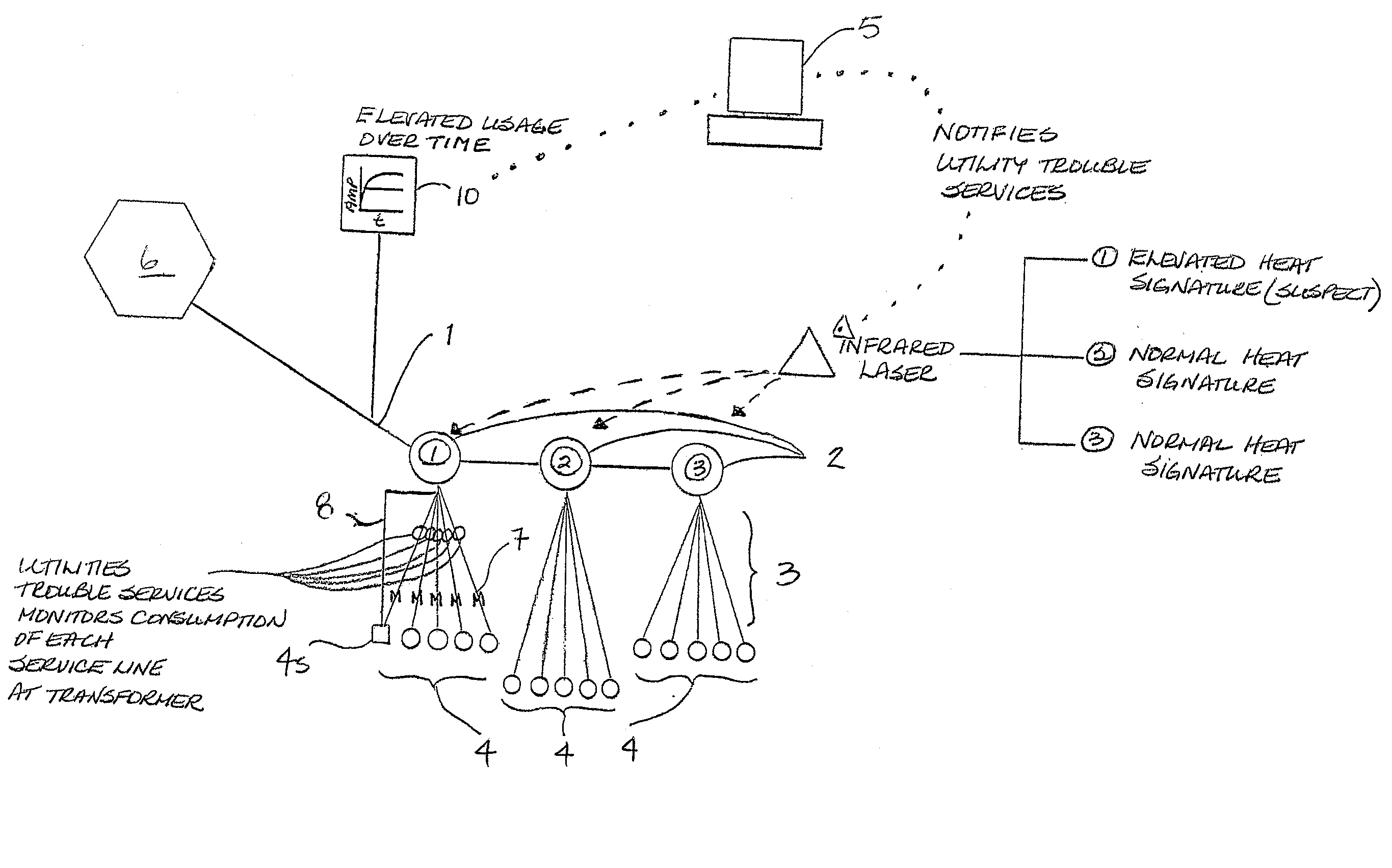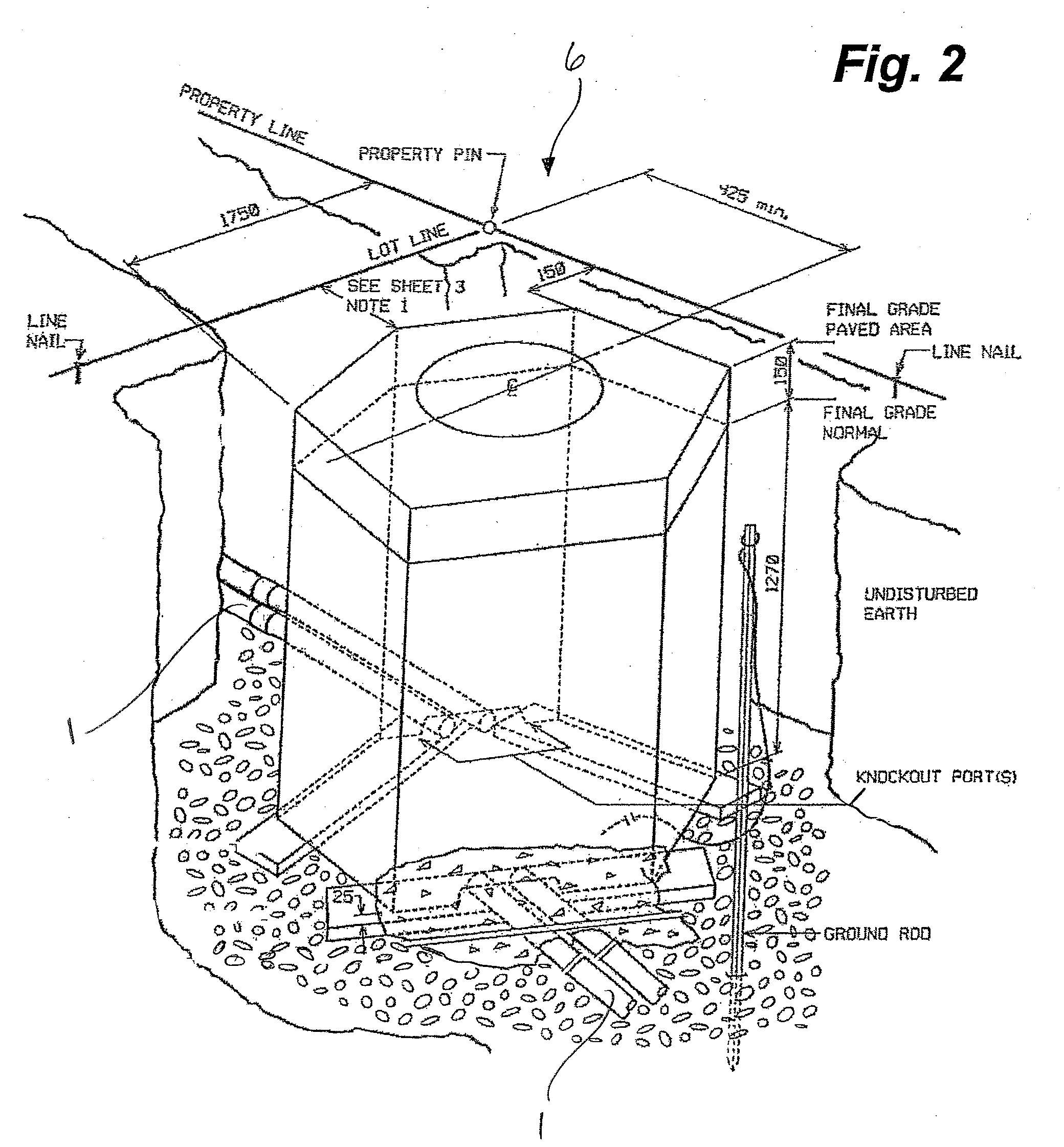Electrical profile monitoring system for detection of atypical consumption
a technology of atypical consumption and a monitoring system, which is applied in the direction of transmission systems, electric vehicles, vehicle components, etc., can solve the problems of electrical theft, little monetary recovery through court actions, and millions of dollars of loss per year
- Summary
- Abstract
- Description
- Claims
- Application Information
AI Technical Summary
Benefits of technology
Problems solved by technology
Method used
Image
Examples
example 1
[0042] Following identification of a suspect primary line 1, heat signature comparisons of the transformers 2 were made using a 3M Scotchtrak Infrared IR-60L2 Series infrared laser, available from 3M Canada, London Ontario, Canada. The results are shown in Table B. The emissivity values of the unit was operated at 0.92 (unit preset) and 0.80 (value for steel) without appreciable difference. The comparisons were performed on a sunny day (not preferred) at 10:30 am at an ambient temperature of 8.4° C. (47.1° F.).
[0043] A digital recording ammeter placed on one of two incoming services lines from a suspect transformer 2 gave a reading of 31 amps over a predetermined period of time. Without load testing, a presumption was made that the amperage load for both lines was approximately double or 62 amps. Three additional transformers 2 in the grid of ten transformers 2 being fed from the primary line 1 were measured for comparison. The three additional transformers 2 were selected to have ...
example 2
[0044] Following identification of a suspect primary line 1, heat comparisons were made using the same equipment identified in the first example and are shown in Table C. The comparisons were performed at dawn at an ambient temperature of 8.9° C. (48.0° F.). Approximately three hours later, a load test was performed on both secondary lines 3 feeding into the now-identified grow operation. The results were 60.3 amps and 71.8 amps. Once inside the residence 4s, it was confirmed from the timers that the amperage readings at the time the heat comparisons were performed were the same as when the load testing was done. Seven additional transformers 2 in the grid of ten transformers 2 being fed from the primary line 1 were measured for comparison. Of note, all dwellings 4 in the residential area were of approximately the same size.
TABLE CHeat readingHeat readingTransformer# of services(Celsius)(Fahrenheit)Suspect1016.862.21910.651.121010.550.931110.651.141110.550.951110.550.9698.547.3788...
example 3
[0045] As shown in FIG. 11, a residential community having 37 active residences was monitored using an embodiment of the invention for the presence of a grow-op. A meter 10 was placed on the primary line 1 feeding transformers 2 (31W-3 to 31W-7). As shown in FIG. 12, a reading of 2.6 amps was initially obtained at 1315 hours on Day 1. Subsequently, an atypical consumption pattern was observed over a predetermined time period.
[0046] Heat signatures of the transformers 2 (31W-3 to 31W-7) were measured, as shown in Table D, and it was noted that one transformer 2 (31W-4) had a heat signature which exceeded that of the other transformers 2 fed by the primary line 1.
TABLE DHeat readingHeat readingTransformer# of services(Celsius)(Fahrenheit)31W-768.747.731W-689.048.231W-588.847.831W-4 (suspect)812.955.231W-378.847.8Margin from highest3.97.0to second highest
[0047] Subsequent load testing identified the suspect residence 4s which was entered on Day 2 at 1420 hours. An electrical bypass ...
PUM
 Login to View More
Login to View More Abstract
Description
Claims
Application Information
 Login to View More
Login to View More - R&D
- Intellectual Property
- Life Sciences
- Materials
- Tech Scout
- Unparalleled Data Quality
- Higher Quality Content
- 60% Fewer Hallucinations
Browse by: Latest US Patents, China's latest patents, Technical Efficacy Thesaurus, Application Domain, Technology Topic, Popular Technical Reports.
© 2025 PatSnap. All rights reserved.Legal|Privacy policy|Modern Slavery Act Transparency Statement|Sitemap|About US| Contact US: help@patsnap.com



